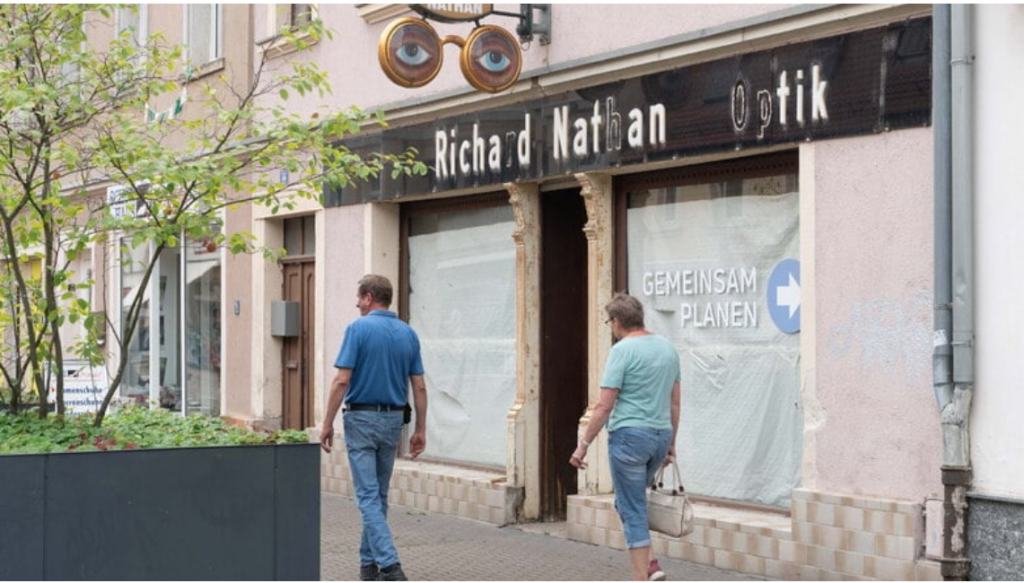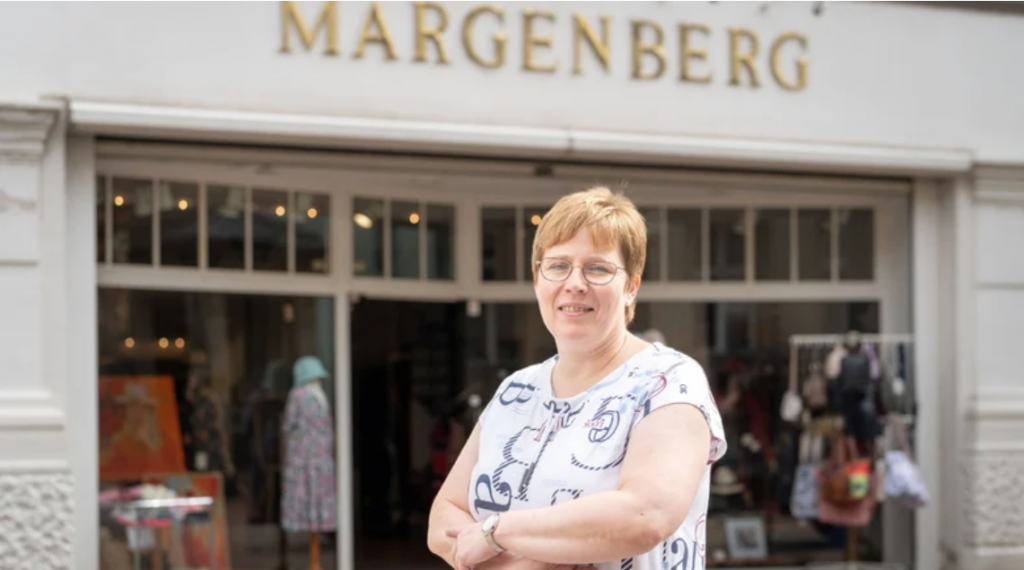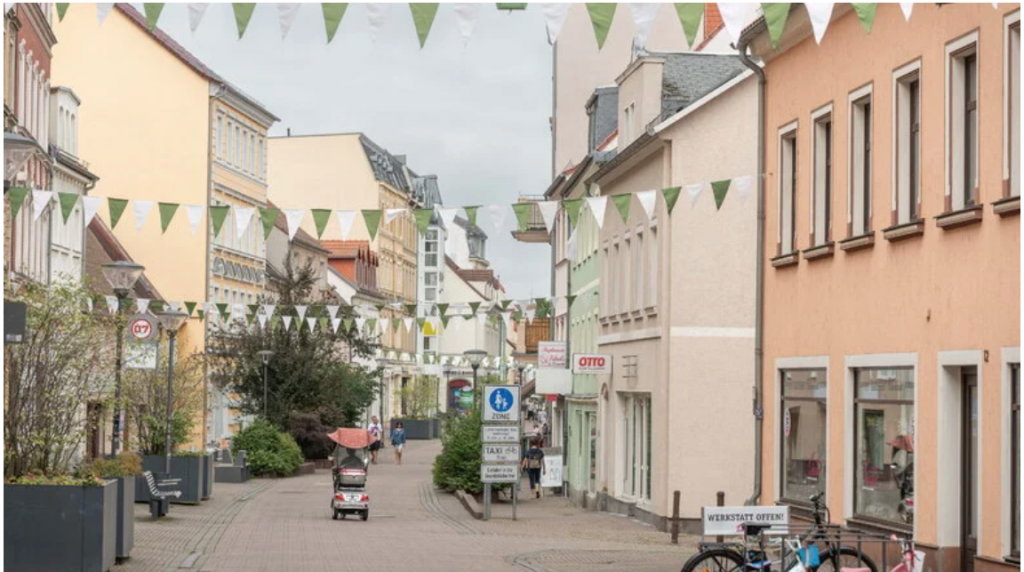From Henry Berndt
Curtains with floral patterns, vertical blinds, classic roller shutters, stickers: there are many ways to conceal the void. Examples of each variant can be found on Riesa's main street. In recent years, an unknown person has also repeatedly written the word "LEER" (empty) in white paint on shop windows. Criticism or sober observation? One thing cannot be overlooked: the boulevard, which is more than one and a half kilometers long, is in danger of dying out. Not even the pretty white and green pennant strings between the walls can cover that up.
Between Tourist Information and Rathausplatz, every second store is now empty, including the one with the large glasses above the shop window. The optician Carl Richard Nathan had been running his store at number 33 since 1894. His son and grandson continued to run the business successfully for more than a century, but about ten years ago it was closed - to the dismay of the remaining regular customers. The small house urgently needed to be renovated, but even after a forced auction at the beginning of the year, nothing happened. A typical case of: no one can or wants to pay.

Historically grown, Riesa has no center with a central market place. Instead, the boulevard runs parallel to the Elbe through the city center. Before reunification, cars still drove on what was then Ernst-Thälmann-Strasse. The transformation into a pedestrian zone began in 1991. At that time, the decision was still linked to the idea of providing window shoppers with the optimal shopping experience.
Annett Margenberg can still remember the golden days of the early 1990s well. The50-year-old comes from a family of furriers and is the seventh generation to run the leather goods store on Hauptstraße. "Until the fall of the Berlin Wall, we only carried furs, then we added leather jackets and bags." Customers were lining up at Margenbergs.
"Like everywhere else, there was a huge backlog," she says. But times have changed, she adds. Although sales are reasonably stable, she says, rapidly rising costs are robbing the profits. It's already clear that Annett Margenberg will be the one to lock up the store behind her one last time.

As recently as 2009, the Riesa city council announced that in future it would aggressively advertise with the slogan "Saxony's longest shopping mile". 14 years and dozens of business closures later, there is no longer any talk of this. The boulevard has long since gone from being a figurehead to a burden.
For the city and for each of the remaining retailers, whose location makes each new gap less attractive. With slogans such as "We sew just about everything" and "Summer vacation for the skin," they advertise for attention. Anyone who eats the "gigadöner" in half pita bread in the kebab store within 20 minutes on their own under supervision gets their money back.
Despite these tempting offers, the street remains almost empty on this Wednesday morning. As is so often the case, many merchants are waiting for that one customer they've been busting their tails for. Those who are fed up simply leave, as three clothing stores recently did in one fell swoop. Even larger chains like Tchibo and Ernsting's Family could not be kept.
For the past two years, Anja Dietel, whose business card reads "City Center Manager," has been responsible for more optimism. The 44-year-old is the first point of contact for all questions from traders and customers. She can be reached in her contact office in the middle of the boulevard. Among other things, she helps with business transfers, talks to property owners, gives workshops for voluntary initiatives and supports events that are intended to attract more people to the main street again: Car Mile, Cocktail Mile, Volunteer Mile, Running Mile.

However, even Anja Dietel can't work magic. "We have to be honest. The thriving retail trade we knew from past decades will no longer exist in this form. It's not coming back." Who still presses their nose against the shop window today and spies that one item in the display that they desperately want? Amazon and Co. have long since replaced this part of life culture. On the Internet, the new dress is just a click away, is delivered to the customer's home within a few hours, and is usually even ten euros cheaper.
New ideas and concepts are now needed for the city center, says Anja Dietel, talking about galleries, pop-up stores and plenty of space for living. The fact that insurance companies and law firms now have their domiciles where bakers and fashion stores once welcomed their customers is part of the transformation. All smaller cities are undergoing this development, she says. Not only in Saxony. Not just in the east.
The Saxon Ministry of Economics is aware of the challenge. With the Corona pandemic, the "structural shifts at the expense of stationary trade" have once again accelerated dramatically. "Due to the increasing vacancies, shopping streets and entire city centers are losing their attractiveness," the ministry informs. Lively centers not only serve consumption, but are also a meeting place and a part of a city's identity. However, solutions must be found locally. There are no patent remedies.

In addition to the well-known problems, the sheer length of the shopping mile in Riesa is another factor. Many of the buildings cannot be supplied from the back and are owned by senior citizens who have neither the strength nor the money to invest in refurbishment, says Anja Dietel.
As Riesa's population shrinks, so does the number of potential customers. Since the mid-1990s, the former industrial city has lost a third of its citizens. Pride in Riesa as a home town is not all that great today. A large proportion of the locals take an extremely critical view of their own town and its prospects, like this elderly woman who is walking quickly along the boulevard.
"This used to be the gossip mile," she says. "You only had to walk back and forth once and you knew what was going on." Now she only comes here on Wednesdays, when there's a market in the town hall square. "Just take a look around. This is a dying retirement town here. Where is it going to go from here?"
Downtown manager Anja Dietel can't understand why so many people are already writing off Riesa. "They only see the empty stores, but too rarely appreciate what they have here." Toward the Elbgalerie shopping center, the main street becomes noticeably livelier. Here there is a café, a sports store, a bookstore, even a movie theater, in front of which a musician plays the accordion.
Anja Dietel believes that in the near future there will be more living than trading on Riesa's Hauptstraße. Even on the first floor, although money would first have to be found for conversion measures. Because of the large window panes, heating can hardly be effective in winter. "Nevertheless, there is a tremendous amount of potential there. Here in the city center, we are largely barrier-free and right in the middle of life."
Sometimes Riesa residents come to her contact office and demand that she please locate a new café. She has to disappoint these citizens at first. "But I'm happy to help if the initiatives come from the community." As city center manager, she has a budget of zero euros at her disposal - subsidies excluded. Anja Dietel is neither an office manager nor a patron, but she offers business management expertise and a growing network from which everyone can benefit. For weeks, she has been distributing flyers with the inscription "Dabeisein, Mitreden, Mitgestalten". A survey on the downtown development area.
From the point of view of the Saxony Trade Association, Riesa needs to pick up the pace. Above all, anchor points such as the Elbgalerie should be developed more quickly, says CEO René Glaser.
A lot has to fit together to achieve the turnaround. Creative concepts, financially strong supporters, but above all, willing residents. "The survival of the shopping streets is in the hands of the customers," says the Ministry of Economics.
And they still exist in Riesa, brave newcomers like Peggy Rudolph. A few weeks ago, she took over a fabric store on Hauptstraße and christened it "Mamasign" - after an idea from her children. She has been sewing scarves for three years. When the previous owner of the store approached her, she didn't have to think twice. Now Peggy Rudolph runs her first own business.
"I have the advantage that fabrics are something people want to touch. They are only suitable to a limited extent for online trading," says the 41-year-old, who also continues to rely on her permanent position with a chemical company. For the time being, she opens her store five times a week for three, four or sometimes seven hours.

Other providers have shortened their opening hours even further or even work only with appointments. This is also the plan of photographer Stefan Jäckel, who would like to open a studio on the first floor of the former fashion house Georg Haase by the beginning of next year at the latest.
Until then, he still has a lot to do. He has been given a free hand by the landlord to redesign the premises according to his ideas. "It's understandable that not everyone dares to take the step into self-employment in these times," says the 33-year-old, but the main street won't become more lively on its own.
In a somewhat dark drugstore, there is a sweet smell of soap and washing powder. The windows on the displays are spotlessly clean. On offer are Sil, Ata and Spee. But there haven't been any customers here for a long time. Only visitors. The store is part of the permanent exhibition on the second floor of the Riesa City Museum.Who knows, maybe in a few years the museum will also display a store where you can try on shoes, pay for them and take them home. "Mom, what's that?" the little museum visitor might then ask. And mom will answer, "This is how we used to shop."








